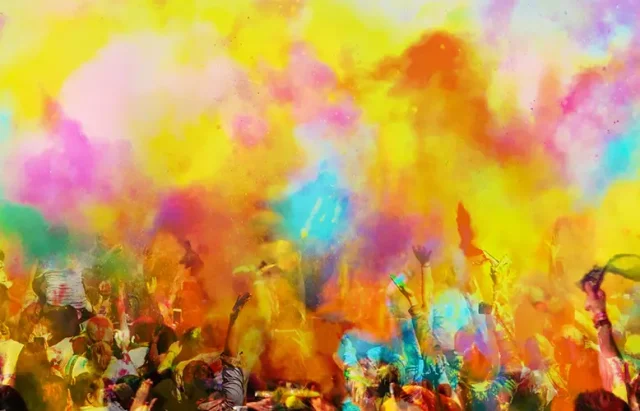
Cultural festivals are a great way to learn about the traditions of other countries, races, and societies. At one time, events like La Tomatina in Spain or Holi in India were celebrated only by the natives of that country, but with the growth of social media and the boom of cultural tourism, festivals like these have been opened up to the world.
There has been a huge increase in festivals of all types (theater, dance, movie, literature, arts, music, and more) in recent years, which has been a benefit to both attendees and the communities that host them. Gatherings like these foster a global sense of community while giving insight into the history and traditions of other cultures in a way that reading articles or watching videos on the internet never could. They also allow natives to express their cultural identity with pride and passion as they share their customs with others.
Despite all the great things about these world fests, however, there is a downside to opening one’s culture up to the world. Social media may help spread the word about these festivals, but it can also lead to overexposure. These festivals, once a relatively private affair, have become the subject of countless articles and Instagram and TikTok videos, making the event itself famous, but not the reasons behind it. What was once perhaps something reverent has now become commercialized. The meaning is getting lost and becoming “gimmicky,” leading some to question if all this cultural openness is such a great thing after all.
Bizarre and Beautiful Traditions on Display
Before getting to the negative side of cultural fests, one must first take a step back and appreciate what the rest of the world has gained from them. Without the increase in visibility for these events, people across the planet may never have learned about the Boryeong Mud Festival in South Korea, for instance. This dirty but delightful custom first began in 1998 and was conceptualized by the Mayor of Daecheon, who, striving to improve the reputation of the local beach’s muddy terrain, created a festival to celebrate mud. Yes, you read that right: mud. Attendees spend two weeks frolicking in a mud pool, sliding on mud slides, painting their bodies with colored mud, and even having mud skiing contests.
Many would also have been unaware of La Tomatina festival in Spain, which is an epic battle in which participants pelt each other with tomatoes that has been going on every August since 1945, or he similar Battaglia delle Arance in Ivrea, Italy, which swaps out tomatoes for oranges.
Oktoberfest in Munich, which originated as a way to celebrate the marriage of King Louis I to Princess Therese von Sachsen-Hildburghausen in 1810, has gained so much fame that this beer-soaked fest is now celebrated in many communities outside of Germany. The Hindu festival of Holi in India celebrates the god Krishna and the end of winter with bonfires, paint-throwing, and splashing gallons upon gallons of colored water, another tradition that has spread across the globe now.
But perhaps one of the most bizarre festivals the world now knows about is the fertility festival of Kanamara Matsuri in Japan. People flock to Kawasaki every spring to attend what is also known as the “Penis Festival,” which features enormous phallic shrines, penis-themed parades, and even foods shaped like that famous male organ and promises luck for pregnant women and those who hope to become pregnant.

Festival Attendance is Soaring
With such interesting festivals happening all around the globe, it is no wonder that festival attendance has been increasing over the past few years. Aside from the fascination with the traditions and practices (and enormous phalluses) involved, this explosion in popularity can also be attributed to a desire to find community and social interaction after the pandemic. People in every city were confined to their homes for months, away from loved ones, friends, and stimulating intellectual and cultural experiences, and now that the pandemic has died down, people want to explore the world that they were cut off from for so long.
As festivals continue to grow in size and scope, there’s also been a noticeable shift in how they’re funded and promoted. Sponsorships now play a bigger role than ever, not just from traditional cultural institutions or beverage brands, but from unexpected players in entertainment and tech. One particularly interesting case is how digital platforms have begun embedding themselves into the festival landscape, not by altering the traditions, but by amplifying the engagement around them.
For example, the team behind Royal Reels, a digital gaming platform, has quietly started exploring cultural integration. Their approach isn’t flashy branding or superficial ad drops. Instead, they’ve built limited-time in-game content inspired by real-world events, borrowing aesthetics and rituals from lesser-known global festivals. It’s a curious intersection: a digital ecosystem mirroring physical celebration. It raises questions about how platforms can contribute to awareness and immersion, especially for users who may never physically attend these events but still seek a taste of that cultural thrill.
Cultural tourism, a phenomenon in which the traveler is driven by the motivation to discover, learn about, and experience other cultures first-hand, has also been on the rise. In a world of faceless emails and smartphone-induced detachment, people don’t just want to have fun on their trips, they want to be immersed in another world.
Add to this the fact that event organizers are making festivals bigger and better than ever in an effort to recoup losses from the lockdown and it is fair to say that festival attendance will likely only increase with time.
Missing the Point
While tourists’ enthusiasm for cultural festivals is both important and appreciated, many of these visitors have begun to miss the point of the traditions they are taking part in. They do not take things seriously, and concentrate more on how the event compares to photos they have seen online or how to make things look fun in their TikTok videos.
There is, for instance, a huge difference between the Mardi Gras that tourists expect and the Mardi Gras that New Orleans residents enjoy. Natalie B. Compton of the Washington Post writes that she has seen both sides, and has found that while tourists look forward to the drinking and debauchery of the event, locals enjoy a whole other side of the event that is “rooted in tradition and is mostly family-friendly” – a side that many tourists will never see.
But it isn’t just locals who are dissatisfied with how traditions have been distorted or commercialized. A traveler on Reddit recently described their experience at the Kurama fire festival in Japan as being “ruined by over-tourism.” Although they themselves were a tourist, they found that the event, which honors the Yuki-jinja Shrine and the spirits associated with it, was packed with so many other tourists that they outnumbered the locals 10 to one. And instead of being respectful of local customs, those tourists were rude to others and disrespectful of the city, all on the interest of getting good photos for their social media pages. As another Reddit user wrote: “Instagram tourism is ruining things. Way too many people are going to things, getting their picture to say they were there, and then leaving.”
And it isn’t just tourists who are missing the point. Sometimes traditions turn into money-making opportunities when vendors in the area decide to capitalize on the influx of visitors, increasing prices of everything from food to hotels to basic essentials. This can turn what was once a culturally rich celebration into a headache, especially for those who still hold its original value dear.
Understanding Makes for a Better Experience
How, then, can meaning be restored to these cherished world fests? Studies have shown that having a real understanding of the cultural traditions they are witnessing/taking part in at festivals – not just thinking about how their view compares to what they have seen on Instagram – helps tourists enjoy them more. Therefore, cultural tourists should do a deep dive into the traditions that their chosen festival is putting on display so that they can see beyond the shiny influencers and into the true heart of the culture.
Authenticity is also important, as visitors (not just members of that culture) have been shown to feel more satisfied with their experience if they can feel that something is genuine and authentic to a culture, not a commercialized caricature of it. Ultimately, world festivals can be enriched by going back to their roots and doing the one thing they were always meant to do: celebrate culture.





